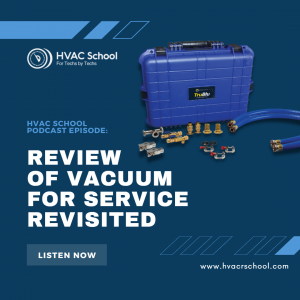Review Of Vacuum For Service Revisited

In this podcast episode, Bryan goes through the addendum to the book Review of Vacuum for Service Engineers. He and Jim Bergmann had the honor of revising the latest edition in 2020. You can get the latest edition of Review of Vacuum for Service Engineers from TruTech Tools HERE.
Pulling a Schrader core before evacuation makes a big difference in the speed of the evacuation. You can use a core remover tool to pull the cores when the system is NOT pressurized.
There are three common types of ports to access the system: the Schrader core, high-flow core (CoreMax), and the multi-position service valve. You can mid-seat the multi-position service valve for high flow, but you need to remove or depress cores on the other two port types. (You must use a special CoreMax CRT to remove high-flow cores.)
Three factors limit the speed of evacuation: the conductance speed of the pump, of the connecting hoses, and of the system. The hoses and manifold can severely impact evacuation. TXV and piston metering devices have short orifices and have very little impact on the evacuation time; on TXVs and EXVs, the valve should be fully open.
When pulling a vacuum, make sure the vacuum pump works properly and has clean oil. Once you know that the pump is working, only pull on a tight system (no leaks) and make sure the seals are in good shape.
Bryan also discusses:
- Micron gauge and hose placement
- Core depressors and CRTs
- Refrigerant holding charge
- When core restrictions are helpful
- Single-hose vs. two-hose evacuation speed
- Moisture removal
- One-hose evacuation of a split air conditioner
- Decay testing
- Hard shut-off valves
- How to solve micron gauge issues
- Nitrogen sweeps for wet systems
If you have an iPhone, subscribe to the podcast HERE, and if you have an Android phone, subscribe HERE.
Check out our handy calculators HERE.
Check out information on the 2022 HVACR Training Symposium at https://hvacrschool.com/symposium/.
Author:









Comments
To leave a comment, you need to log in.
Log In